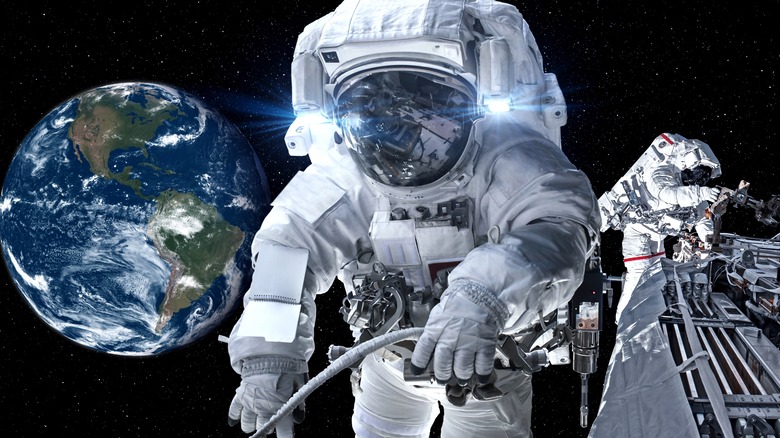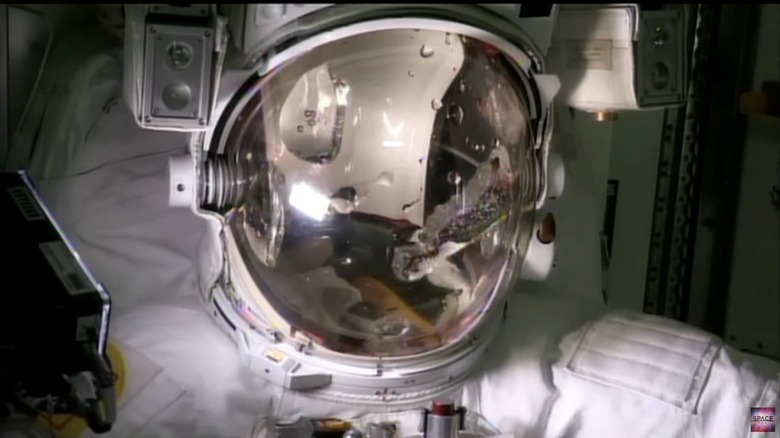The Faulty NASA Spacesuit That Nearly Drowned An Astronaut
With the continued delays of the Artemis I launch, it's a good time to remember that going into space is hard. Despite the difficulty, the exorbitant cost, and the fact that danger could come from an infinite number of reasons, humans still continue to reach for the stars.
Since the Space Race began, there have been numerous accidents that were both fatal and non-fatal. The first American fatality happened on January 27, 1967, during a test launch for the first Apollo mission. An electric fire from faulty wiring caused a spark that ignited a fire inside the command module, which was filled with oxygen at the time. The fire spread so quickly that astronauts Virgil "Gus" Grissom, Edward White, and Roger Chaffee couldn't open the hatch on the module fast enough, and all three died of asphyxiation.
In April of 1970, the three-person crew of Apollo 13 managed to survive several catastrophic failures, any of which could have killed them. After alerting Houston that they had a problem, quick thinking and ingenuity on the ground and in space managed to get them all back to Earth safely. On January 28, 1986, the space shuttle Challenger explosion killed all seven astronauts (Francis Scobee, Michael Smith, Ronald McNair, Ellison Onizuka, Judith Resnik, Gregory Jarvis, and Christa McAuliffe) on board. The accident was traced back to faulty O-rings damaged by the cold temperatures the morning of the launch.
Accidents have happened on the International Space Station as well.
Like being a goldfish inside a fish bowl
On July 16, 2013, European Space Agency astronaut Luca Parmitano and NASA astronaut Chris Cassidy were on what was supposed to be a six-hour space walk outside the ISS. About an hour into the mission, Parmitano, who had become Italy's first astronaut to walk in space only a week before, reported that he was started to feel a lot of water on the back of his head.
At first, he thought it might have been coming from his drinking bag, so he gulped that down, but unfortunately, the water continued to flow into his helmet. Parmitano realized it was cold, which wasn't normal, and informed Mission Control. They quickly aborted the extra-vehicular activity (EVA) and ordered him to return to the airlock.
As the Italian astronaut began to make his way back, he could feel the water cover the cupped sponges in his earphones to the point he couldn't hear anything. Then the water "completely covered" his eyes and stuck to the visor, making it nearly impossible to see. According to Parmitano, the scariest part was when the upper part of the helmet became full of water, and he wasn't sure if the next breath he took would be air or liquid.
He made his way back to the airlock by following his safety cable and just going off memory, and his fellow crew members helped get him safe, secure, and dry (via Space). An estimated two to three pints of water had accumulated inside Parmitano's helmet (via the Los Angeles Times). After the incident, he said it felt like he was a "goldfish inside a fish bowl."
Don't go chasing waterfalls in space
During the follow-up investigation by the Mishap Investigation Board, NASA had the crew recreate the failure by sealing up an empty suit and switching it on. Water again poured back into the helmet, and NASA placed an immediate hold on all further "non-urgent" EVAs until they could figure out what caused the issue in the first place.
The investigation found that the water entered the helmet through the ventilation port in the back because the suit's life-support system filter had become clogged. According to Chris Hansen, chairman of the investigative board, this equipment failure — something NASA calls a "high visibility close call" — was "probably the most serious" EVA issue "encountered to date."
A similar leak had occurred just a week earlier with these identical two astronauts. At the time, Cassidy and Parmitano thought the much smaller amount of water was coming from "a leaky drink bag," which was also their initial thought the second time it occurred (via Space). NASA blamed it on the bag and never followed up. "This event was not properly investigated, which could have prevented placing a crew member at risk a week later," Hansen said. NASA fixed the cause of the leak, and EVAs soon resumed.
The July 13th space walk was one of the station's shortest in its history (via Space). And Parmitano wrote a first-hand account of the experience in a blog for the European Space Agency.

